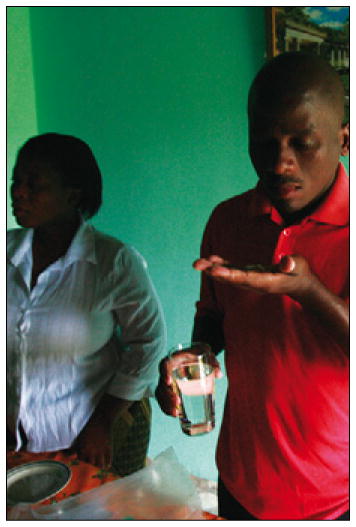
Despite its claims, the study by Frank Tanser and colleagues1 is not “a formal test of the concurrency hypothesis”. The analysis does not tell us whether a woman in this community is more likely to become HIV positive if her partner(s) have concurrent partners, because Tanser and colleagues did not measure this; they measured the future risk a woman faces from the past characteristics of men who live within a few km radius of her.
The model assumes that women’s sexual relationships are most likely to be with their immediate neighbours, become increasingly less likely with men living somewhat farther away, and are non-existent with men who live beyond 2·5–3·8 km. These assumptions are neither credible nor supported by the empirical evidence in this study. Furthermore, the estimated coefficient on neighbourhood men’s lifetime partners does not change after controlling for HIV prevalence. This either means that neighbourhood men’s previous behaviour affects a woman’s future incidence even in a neighbourhood with no HIV-infected men, or it means that there is something wrong with the model, the data, or both.
The data, like the model, have serious problems, the most important of which is the very low response rates. Tanser and colleagues report that the HIV testing response rate was 63%, but factoring in the low contact rate, only 43% of eligible respondents were tested in the first wave, falling to only 34% by the third wave.2 Refusal to test was linked to higher HIV risk and prevalence.3,4 Non-response was high for the behavioural measures too: 25% of women did not complete the sexual behaviour questions, and 37% of men refused to participate in the 2004 behavioural survey.
One does not have to turn to such convoluted, indirect analytical strategies to test the concurrency hypothesis. Direct empirical evidence comes from nine published studies,5–13 spanning 20 years and multiple sites in sub-Saharan Africa, none of which is cited by Tanser and colleagues. In these studies, half to three-quarters of observed HIV incidence in stable couples can be definitively attributed to concurrent sexual partners. It is not acceptable to state that “the effect of concurrent partnerships on HIV incidence has not been appropriately tested in a sub-Saharan African setting”.1
The tone of the academic debate about the effect of concurrent partnerships on HIV risk is puzzling. Science and policy would be best served by moving beyond the longstanding partner reduction messages to test specific concurrency reduction interventions the old-fashioned way, with a multisite randomised controlled trial. Such studies are in development, and, contrary to Tanser and colleagues’ assertions, they are quite feasible.
Footnotes
We declare that we have no conflicts of interest.
References
- 1.Tanser F, Barnighausen T, Hund L, Garnett GP, McGrath N, Newell M-L. Effect of concurrent sexual partnerships on rate of new HIV infections in a high-prevalence, rural South African population: a cohort study. Lancet. 2011;378:247–55. doi: 10.1016/S0140-6736(11)60779-4. [DOI] [PMC free article] [PubMed] [Google Scholar]
- 2.Tanser F, Hosegood V, Barnighausen T, et al. Cohort profile: Africa Centre Demographic Information System (ACDIS) and population-based HIV survey. Int J Epidemiol. 2008;37:956–62. doi: 10.1093/ije/dym211. [DOI] [PMC free article] [PubMed] [Google Scholar]
- 3.Nyirenda M, Zaba B, Baernighausen T, Hosegood V, Newell M-L. Adjusting HIV prevalence for survey non-response using mortality rates: an application of the method using surveillance data from rural South Africa. PLoS One. 2010;5:e12370. doi: 10.1371/journal.pone.0012370. [DOI] [PMC free article] [PubMed] [Google Scholar]
- 4.Welz T, Hosegood V, Jaffar S, Batzing-Feigenbaum J, Herbst K, Newell M-L. Continued very high prevalence of HIV infection in rural KwaZulu-Natal, South Africa: a population-based longitudinal study. AIDS. 2007;21:1467–72. doi: 10.1097/QAD.0b013e3280ef6af2. [DOI] [PubMed] [Google Scholar]
- 5.Serwadda D, Gray RH, Wawer MJ, et al. The social dynamics of HIV transmission as reflected through discordant couples in rural Uganda. AIDS. 1995;9:745–50. doi: 10.1097/00002030-199507000-00012. [DOI] [PubMed] [Google Scholar]
- 6.Carpenter LM, Kamali A, Ruberantwari A, Malamba SS, Whitworth JAG. Rates of HIV-1 transmission within marriage in rural Uganda in relation to the HIV sero-status of the partners. AIDS. 1999;13:1083–89. doi: 10.1097/00002030-199906180-00012. [DOI] [PubMed] [Google Scholar]
- 7.Hugonnet S, Mosha F, Todd J, et al. Incidence of HIV infection in stable sexual partnerships: a retrospective cohort study of 1802 couples in Mwanza Region, Tanzania. J Acquir Immune Defic Syndr. 2002;30:73–80. doi: 10.1097/00042560-200205010-00010. [DOI] [PubMed] [Google Scholar]
- 8.Senkoro KP, Boerma JT, Klokke AH, et al. HIV incidence and HIV-associated mortality in a cohort of factory workers and their spouses in Tanzania, 1991 through 1996. J Acquir Immune Defic Syndr. 2000;23:194–202. doi: 10.1097/00126334-200002010-00012. [DOI] [PubMed] [Google Scholar]
- 9.Gray R, Ssempijaa V, Shelton J, Serwadda D, Nalugoda F, Wawer MJ. The contribution of HIV-discordant relationships to new HIV infections. AIDS. 2011;25:1343–44. doi: 10.1097/QAD.0b013e3283448790. [DOI] [PMC free article] [PubMed] [Google Scholar]
- 10.Mermin JJ, Musinguzi J, Opio A, et al. Risk factors for recent HIV infection in Uganda. JAMA. 2008;300:540–49. doi: 10.1001/jama.300.5.540. [DOI] [PubMed] [Google Scholar]
- 11.Celum C, Wald A, Lingappa JR, et al. Acyclovir and transmission of HIV-1 from persons infected with HIV-1 and HSV-2. N Engl J Med. 2010;362:427–39. doi: 10.1056/NEJMoa0904849. [DOI] [PMC free article] [PubMed] [Google Scholar]
- 12.Manigart O, Kraft C, Makombe N, et al. Co-and superinfection of partners in a cohort of couples previously infected by genotypically different viruses in Kigali. Retrovirology. 2009;6 (suppl 3):P384. [Google Scholar]
- 13.Trask SA, Derdeyn CA, Fideli U, et al. Molecular epidemiology of human immunodeficiency virus type 1 transmission in a heterosexual cohort of discordant couples in Zambia. J Virol. 2002;76:397–405. doi: 10.1128/JVI.76.1.397-405.2002. [DOI] [PMC free article] [PubMed] [Google Scholar]


